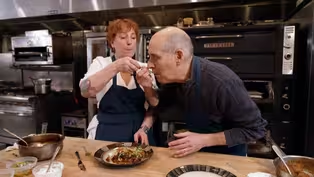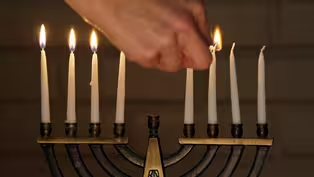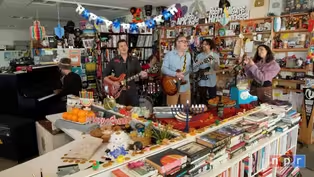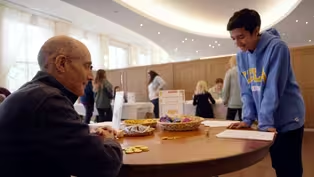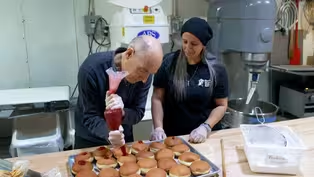
The Story of Hanukkah
Clip: Special | 3m 52sVideo has Closed Captions
Geoffrey explores the story of the Maccabees and the history of Hanukkah.
Geoffrey Baer explores the story of the Maccabees and the history of the Jewish holiday.
Problems playing video? | Closed Captioning Feedback
Problems playing video? | Closed Captioning Feedback
Chicago Tours with Geoffrey Baer is a local public television program presented by WTTW

The Story of Hanukkah
Clip: Special | 3m 52sVideo has Closed Captions
Geoffrey Baer explores the story of the Maccabees and the history of the Jewish holiday.
Problems playing video? | Closed Captioning Feedback
How to Watch Chicago Tours with Geoffrey Baer
Chicago Tours with Geoffrey Baer is available to stream on pbs.org and the free PBS App, available on iPhone, Apple TV, Android TV, Android smartphones, Amazon Fire TV, Amazon Fire Tablet, Roku, Samsung Smart TV, and Vizio.
- Today, most Jews worldwide can celebrate their traditions openly and freely, but it wasn't always this way.
- For thousands of years, our Jewish community, wherever they lived, came up against the oppression of some of the great empires of history.
- One such empire was the Seleucid dynasty when Greeks ruled over much of West Asia more than 2000 years ago, and that's when the Hanukkah story begins.
In the present day, city of Jerusalem, King Antiochus Epiphanes led a campaign to ban Jewish practice.
Antiochus and his army defiled the Jewish temple.
They ordered Jews to worship Greek gods and even sacrificed a pig on the altar.
Worst of all, they snuffed out the temple's, holy, eternal light.
But a small group known as the Maccabees, led by a Jewish priest named Judah, staged a revolt against the monarchy.
They regained control of the temple, removed the symbols of Zeus, and began to rebuild their altar.
- The big picture version of that story is military victory, Jewish sovereignty, throwing off the sort of shackles of empire.
The second story, which is the one that my kids got taught and that I got taught, you know, as a kid in, in, in Hebrew school, is the miracle of the oil.
- As the Maccabees restored their temple, they were desperate to relight their sacred candelabra called a menorah.
But this eternal flame could only be lit with kosher olive oil, a resource that took eight days to produce.
And after searching through the rubble, the Maccabees could only find one tiny jug, just enough to burn for a single night.
- They found oil enough to last for how long one day.
But miraculously, the oil that they found, which was so little, lasted for much longer than they expected.
The oil lasted for eight days, and that's a metaphor for the power of life to fill even the darkest times and to give hope and inspiration to all of us.
- Now, there's historical proof that the Maccabees did exist and that they actually defeated the powerful Seleucid army, but the miracle of the oil, not so much.
- The story about the oil actually is only first being told hundreds and hundreds of years later after the events themselves.
- That part of the story isn't in the Hebrew Bible.
It doesn't actually appear until 600 years later in the books of Jewish law and lore called the Talmud written by a group of rabbis.
Did they just make that story up?
Yes.
Yes.
They made up the story.
- So this is a big question for historians.
Where does this story come from?
- To probe this mystery a little deeper, I paid a visit to my own synagogue, Sukkat Shalom, and spoke to Rabbi Allison Tick Brill.
- Hmm, that's a great question.
Did they make that up?
The rabbis were all about peace.
That was their most important guiding value, and so they would not want to lift up this military story when they had this profound story of light in the darkness.
- This idea that we are responsible for bringing light to darkness has a lot of, a lot of meaning, and I think that's part of the reason that it's captured the imagination of the Jewish community for 2000 years.
Celebrating Hanukkah in the United States
Video has Closed Captions
Clip: Special | 5m 46s | How do modern Jewish families celebrate Hanukkah? (5m 46s)
A Celebration of Hanukkah Trailer
Video has Closed Captions
Preview: Special | 1m 1s | Geoffrey Baer takes viewers on a fun exploration of the time-honored traditions of Hanukkah. (1m 1s)
Video has Closed Captions
Clip: Special | 5m 42s | Chef Mindy Segal demonstrates her latke recipe. (5m 42s)
Video has Closed Captions
Clip: Special | 8m 32s | Why do Jewish families light a menorah at Hanukkah? (8m 32s)
Video has Closed Captions
Clip: Special | 4m 47s | Meet The LeeVees, a Hanukkah band behind the album “Hanukkah Rocks.” (4m 47s)
Video has Closed Captions
Clip: Special | 4m 15s | Geoffrey plays a game of dreidel. (4m 15s)
Video has Closed Captions
Clip: Special | 3m 21s | Geoffrey visits a bakery to learn about sufganiyot. (3m 21s)
Providing Support for PBS.org
Learn Moreabout PBS online sponsorshipSupport for PBS provided by:
Chicago Tours with Geoffrey Baer is a local public television program presented by WTTW


